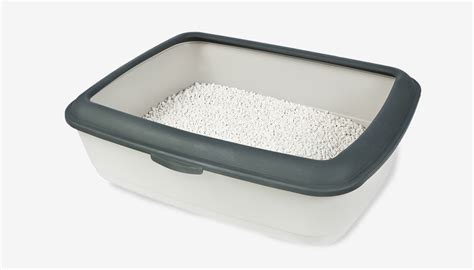What is a Litter Box?
A litter box is a designated area where cats can eliminate waste. It typically consists of a plastic or metal tray filled with absorbent material, such as clay, silica gel, or pine shavings.

Benefits of Using a Litter Box
- Hygiene: Prevents cats from soiling carpets and furniture.
- Convenience: Provides a clean and accessible spot for cats to relieve themselves.
- Behavior: Encourages appropriate elimination habits and reduces inappropriate spraying or marking.
Types of Litter Boxes
- Open: Trays with no roof or partially covered.
- Hooded: Enclosed boxes with a swinging or removable lid.
- Self-cleaning: Automated systems that sift and dispose of waste.
- Disposable: Liners or trays that can be thrown away after use.
Choosing the Right Litter Box
Consider the following factors when selecting a litter box:
- Size: Large enough for the cat to move around comfortably.
- Shape: Square, rectangular, or curved to accommodate the cat’s preferences.
- Location: Private and accessible area away from food and water bowls.
- Type: Based on the cat’s personality, litter habits, and your budget.
Placement and Maintenance
- Place litter boxes in quiet, low-traffic areas.
- Provide one litter box per cat, plus one extra.
- Clean litter boxes daily and replace litter every 1-2 weeks.
- Use a scooper to remove solids and sift the remaining litter.
Q&A Sessions
Q1: How often should I clean the litter box?
A: Daily for solids and every 1-2 weeks for complete replacement.
Q2: What type of litter is best for my cat?
A: It depends on the cat’s preferences, absorption capacity, and dustiness.
Q3: Why does my cat avoid the litter box?
A: Possible reasons include inappropriate placement, dirty litter, or health issues. Rule out any medical conditions with a veterinarian.
Q4: How do I train a kitten to use a litter box?
A: Place the kitten in the litter box after meals and naps, and praise them when they use it correctly.
Q5: What is the best way to dispose of cat litter?
A: Check local regulations. Some areas require double-bagging and disposal in the trash, while others allow disposal in compost heaps or sewer systems.
Q6: Is a self-cleaning litter box worth the investment?
A: It depends on your budget and lifestyle. Self-cleaning litter boxes can save time and effort, but they require regular maintenance and troubleshooting.
Current Status and Future Outlook
Litter boxes have been a staple of cat ownership for decades. With advancements in technology and materials, newer options are emerging, such as:
- Biodegradable litter: Made from plant-based materials, reducing environmental impact.
- Odor-absorbing litter: Formulated with baking soda or activated charcoal to neutralize odors.
- Health-monitoring litter: Sensors that track cat urine and alert owners to potential health issues.
Case Detail Comparison
Case 1: Chloe, a 5-year-old domestic shorthair, had recurrent urinary tract infections (UTIs). Her veterinarian suspected inappropriate elimination habits, leading to bacterial buildup in the bladder. By addressing Chloe’s litter box hygiene and providing a second litter box in a more secluded location, her UTIs resolved.
Case 2: Max, a 10-year-old Siamese, started spraying urine outside the litter box. His owner consulted a behavioral specialist who diagnosed stress-induced marking. Implementing environmental enrichment, such as vertical scratching posts and puzzle feeders, along with pheromone therapy, helped reduce Max’s anxiety and eliminate the inappropriate elimination.
Conclusion
Litter boxes play a crucial role in maintaining feline hygiene, health, and well-being. By understanding the different types, placement, and maintenance requirements, cat owners can provide their feline friends with a clean and comfortable space to eliminate waste. As technology continues to evolve, litter boxes are becoming more innovative and sophisticated, further enhancing the lives of cats and their owners.





















